Nevşehir, located in Central Anatolia in Turkey, is known for its natural beauty and rich birdlife. The area is home to various species, from the majestic Lammergeier vultures to the colorful Bee-eaters to the mysterious Scops Owls.
With its diverse topography, ranging from rocky hills and canyons to lush green valleys and meadows, Nevşehir is an ideal spot for birdwatching.
Bird enthusiasts can find a variety of habitats and species in the area and observe everything from soaring raptors to tiny warblers and woodpeckers.
Whether you’re a novice or an experienced birdwatcher, Nevşehir offers an opportunity to explore and appreciate the natural beauty of the area and its abundant avian life.
19 Birds to Watch in Nevşehir
If you are a bird lover, you might want to visit Nevşehir, a province in Central Anatolia, Turkey. Nevşehir is famous for its natural wonders, such as the fairy chimneys and the underground cities, but it is also a great place to see some amazing birds.
Here are 19 birds that you can watch in Nevşehir, from the common to the rare, from the small to the large, from the colorful to the plain.
1. White Stork
The white stork is a species of bird belonging to the family Ciconiidae. It is large compared to other storks and has a distinctive plumage of mainly white feathers, with black on its wings. Adult white storks have long, red legs and a long, pointed, red beak.
On average, they measure between 100 and 115 cm in length from the tip of the beak to the end of the tail and have a wingspan of between 155 and 215 cm.
The white stork is a striking bird and is easily identifiable by its unique combination of white feathers, red legs, and beak.
| Kingdom | Animalia |
| Phylum | Chordata |
| Class | Aves |
| Order | Ciconiiformes |
| Family | Ciconiidae |
| Genus | Ciconia |
| Species | C. ciconia |
2. Black Stork
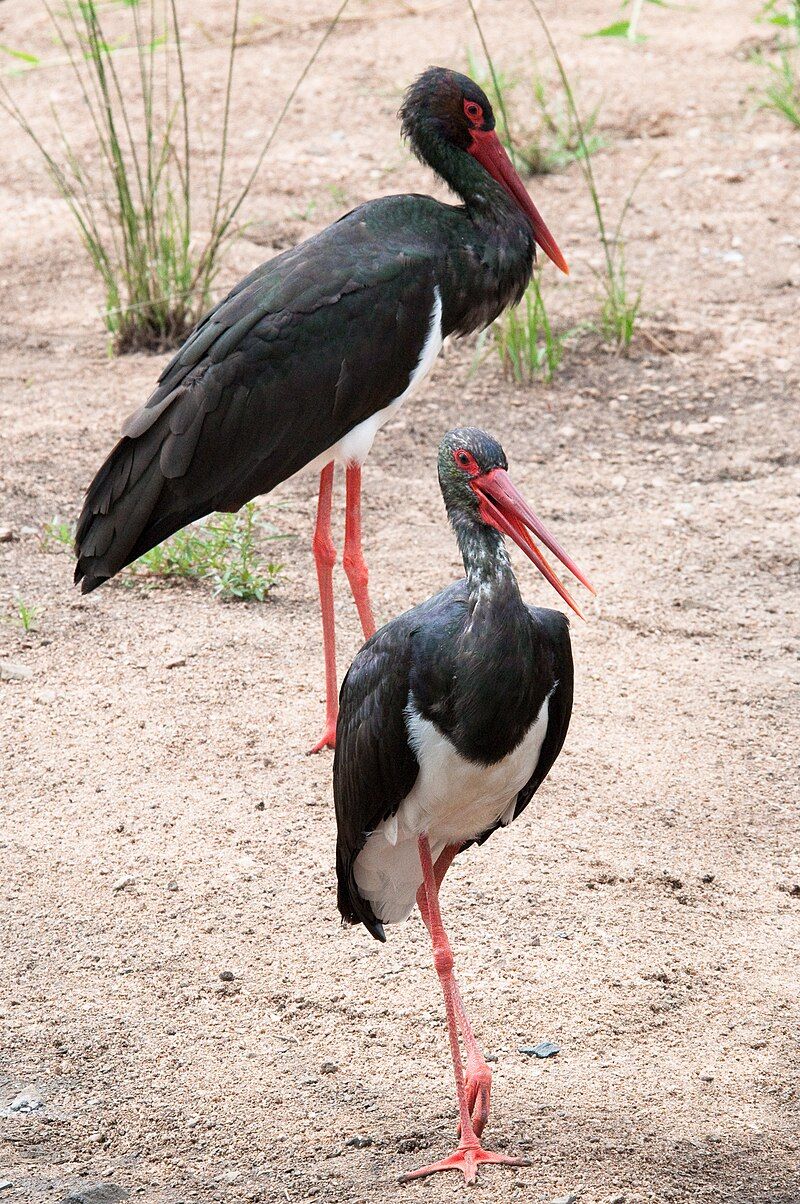
The black stork is a large bird species belonging to the family Ciconiidae. It is a widespread species, with a range stretching from Europe and Asia to parts of Africa. This species was first officially described by Carl Linnaeus in the 10th edition of his Systema Naturae.
The black stork is a large bird standing up to 1 meter in height with a wingspan of around 1.5 meters. They are mainly black, with white on the rump and underparts. The bill is long and curved, and the legs are pinkish-red.
They prefer wetland habitats, where they can feed on fish and amphibians. They also take advantage of nearby agricultural land to feed on rodents and insects. Black storks are primarily solitary birds but can be found in small flocks during the winter months.
They are primarily migratory, with some birds spending the winter in the southern parts of their range.
| Kingdom | Animalia |
| Phylum | Chordata |
| Class | Aves |
| Order | Ciconiiformes |
| Family | Ciconiidae |
| Genus | Ciconia |
| Species | C. nigra |
3. Peregrine Falcon
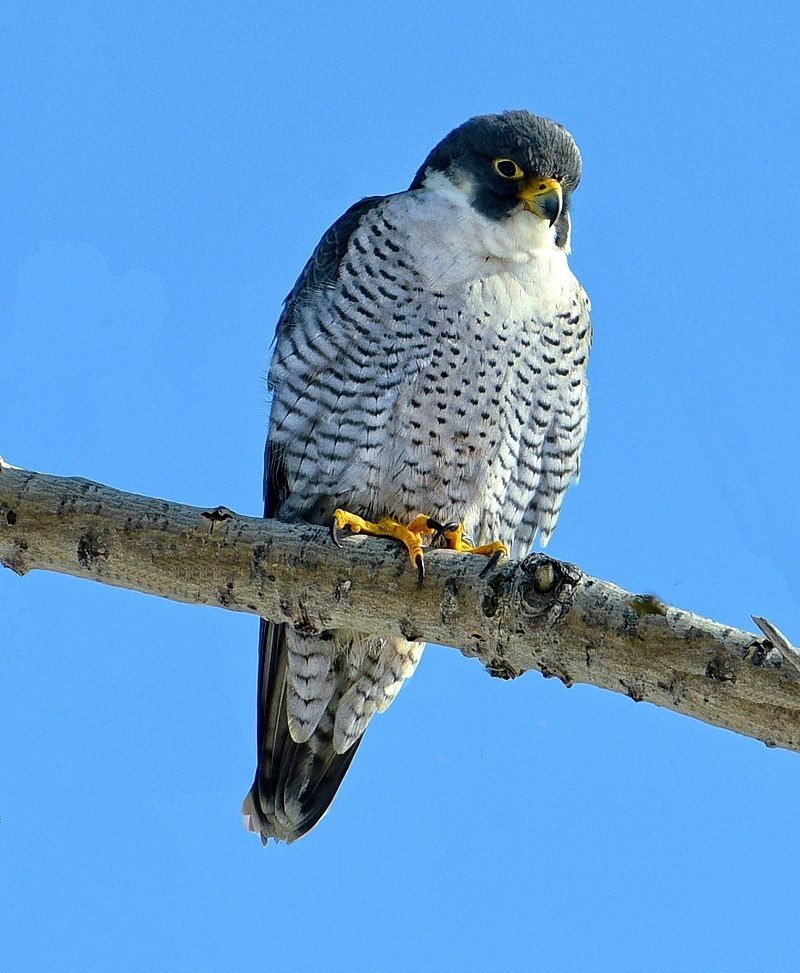
The peregrine falcon is an impressive bird of prey belonging to the Falconidae family. It is recognizable by its size, similar to that of a crow, and its striking appearance, with its blue-grey back, white barred underparts, and black head.
This bird is renowned for its incredible speed, one of the fastest of any animal in the world.
Its speed is so impressive that it earned the nickname ‘duck hawk’ in North America. The peregrine falcon is found in many habitats, from tundras to tropical forests.
Additionally, it can be found in many parts of the world, making it a truly cosmopolitan species. Its diet consists mainly of other birds, which it catches mid-air after diving at incredible speeds from high altitudes.
This impressive hunting technique requires a combination of agility, strength, and speed. The peregrine falcon is also a protected species in many countries, as its population has recently decreased certain pesticides.
In addition, it is illegal to hunt peregrine falcons in many countries. Despite this, the species continues to thrive and can be seen in many different parts of the world. Overall, the peregrine falcon is an impressive bird of prey admired for its speed and agility.
Its cosmopolitan nature means that it can be found in many different parts of the world, and its population has recently been protected due to its decreasing numbers.
| Kingdom | Animalia |
| Phylum | Chordata |
| Class | Aves |
| Order | Falconiformes |
| Family | Falconidae |
| Genus | Falco |
| Species | F. peregrinus |
4. Common Starling
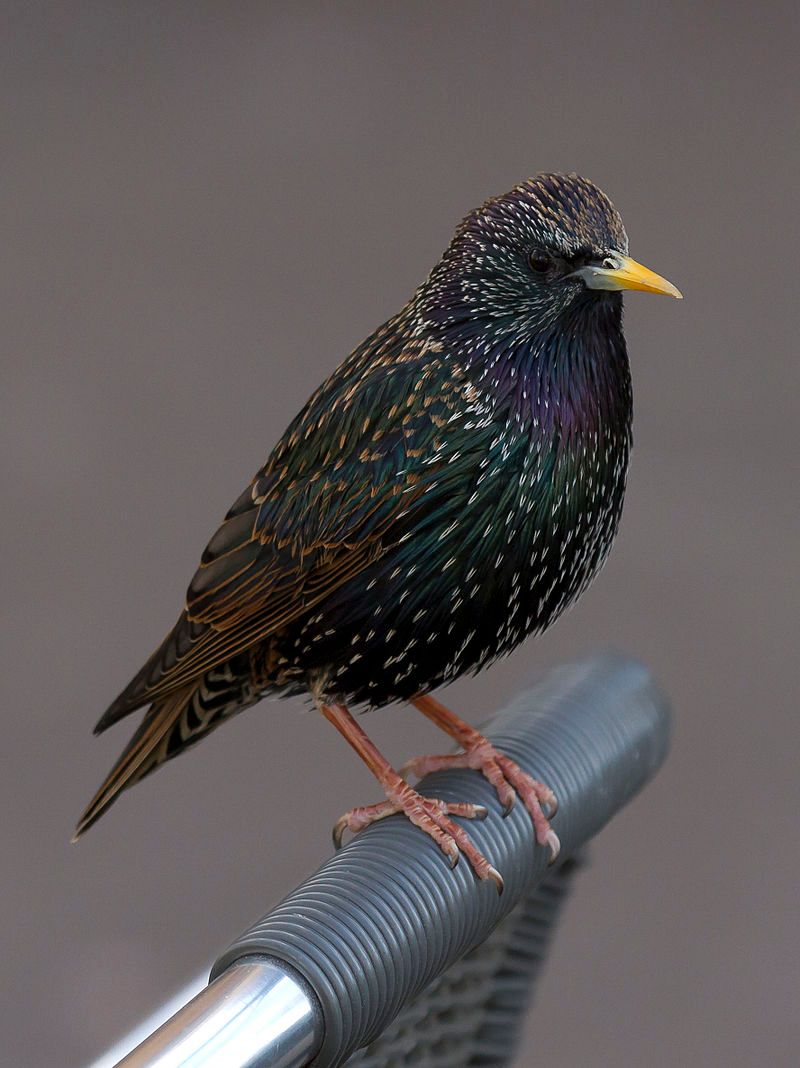
The common starling is a species of bird found throughout Europe, North America, and the United Kingdom. It is part of the Sturnidae family, commonly known as the starling family.
It is considered a medium-sized passerine bird, meaning it is a smaller bird that travels from place to place. In Europe, the common starling is known simply as the starling. However, it is referred to as the European starling in North America.
Similarly, it is known as the starling in Great Britain and Ireland.
This bird species has a glossy black plumage with a metallic sheen and can be found in various habitats, including woodlands, grasslands, and parks. The common starling is an omnivore which feeds on plant and animal material.
It is a social bird, often seen in large flocks. It is also a vocal bird, able to produce a variety of sounds and songs.
It is also known for its mimicry, able to mimic other birds and animals, as well as human-made sounds. The common starling is an important species for many ecosystems. It helps control insect populations and disperse the seeds of certain plants.
It is also a popular species for birdwatchers, as it is relatively easy to observe and identify.
| Kingdom | Animalia |
| Phylum | Chordata |
| Class | Aves |
| Order | Passeriformes |
| Family | Sturnidae |
| Genus | Sturnus |
| Species | S. vulgaris |
5. Eurasian Collared Dove
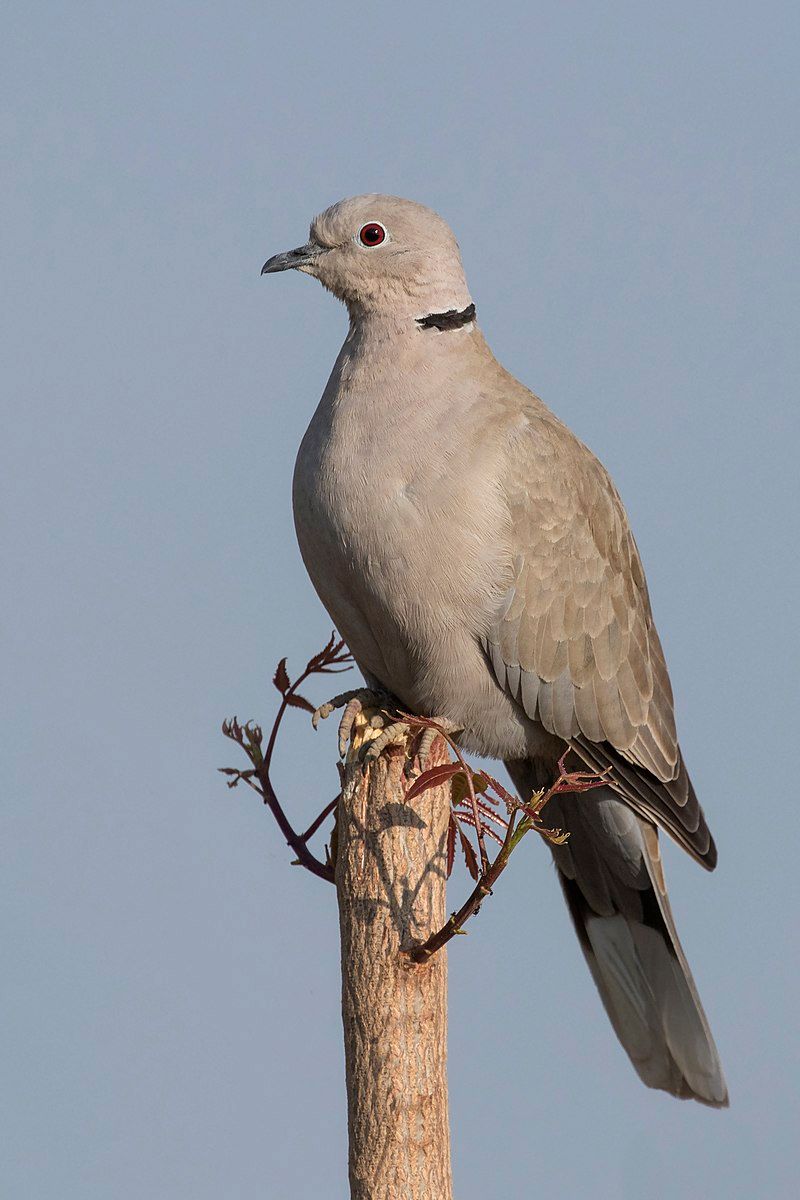
The Eurasian collared dove is a dove species that inhabits Europe and Asia. It was introduced to other parts of the world, including Japan, North America, and the Caribbean islands.
This species has an extensive global range, and its population is increasing, making it one of the least threatened species in the world.
As a result, the International Union for Conservation of Nature (IUCN) has classified it as a species of “Least Concern” on its Red List since 2014. This means that the species is not in danger of becoming extinct shortly.
The Eurasian collared dove is a medium-sized dove measuring around 32-35 cm in length. Its upper parts are greyish-brown, and its underside is pale grey. It has a white collar on its neck, where it gets its name.
The species has adapted well to living near humans and is often seen in parks and gardens. It feeds on a variety of seeds, grains, and fruits. The Eurasian collared dove is a very successful species whose population proliferates.
It has adapted to many habitats and is now found in many parts of the world. Its increasing numbers make it a species of Least Concern on the IUCN Red List, meaning it is not currently at risk of becoming extinct.
However, the species may be threatened by habitat loss and changes in land use. Therefore, protecting the species and its habitat is essential to ensure its survival.
| Kingdom | Animalia |
| Phylum | Chordata |
| Class | Aves |
| Order | Columbiformes |
| Family | Columbidae |
| Genus | Streptopelia |
| Species | S. decaocto |
6. European Turtle Dove
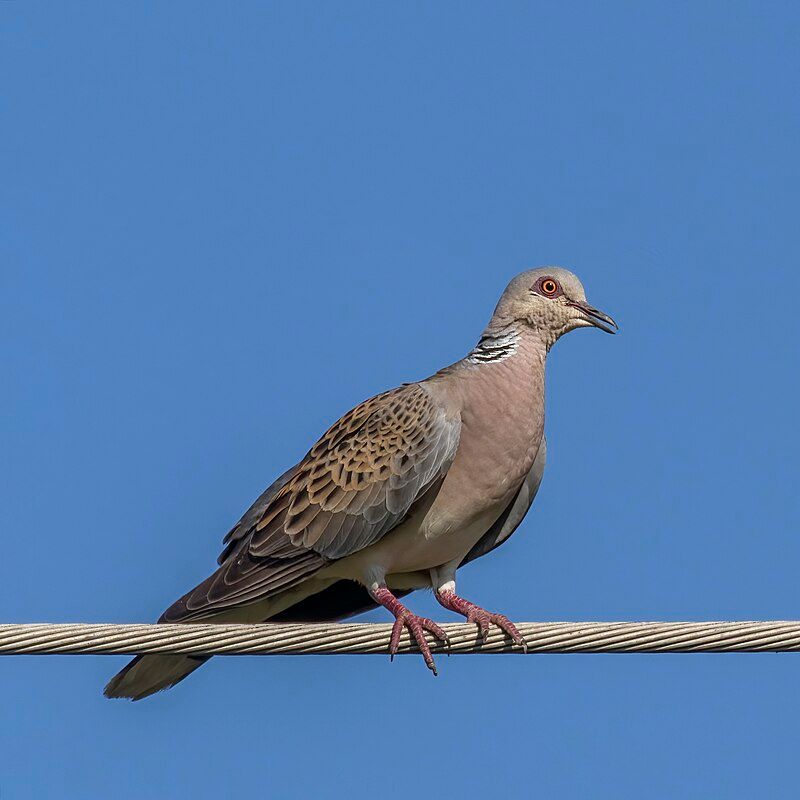
The European turtle dove is a species of bird that belongs to the family Columbidae, which includes doves and pigeons. It breeds in a wide area of the southwestern Palearctic, comprising Europe, the Middle East, and North Africa.
During the winter, it migrates to the northern regions of sub-Saharan Africa for a warmer climate. This dove species is commonly found in meadows, farmland, and other open landscapes, where it feeds on grain and various types of seeds.
It also inhabits gardens and parks, feeding on fruits and berries. The European turtle dove is an important species of bird, as it plays an essential role in the ecosystem; for instance, it helps disperse seeds and aids in the pollination of plants.
| Kingdom | Animalia |
| Phylum | Chordata |
| Class | Aves |
| Order | Columbiformes |
| Family | Columbidae |
| Genus | Streptopelia |
| Species | S. turtur |
7. Common Swift
The common swift is a type of bird that is similar in appearance to the barn swallow or house martin but is slightly larger. It does not belong to the same passerine species as the barn swallow or house martin but belongs to the order Apodiformes.
The similarities between the two groups of birds are not due to their being related but instead are a result of convergent evolution. This means both species have evolved similar characteristics in response to their ecological environment.
For example, the common swift and the barn swallow both have long, slender wings, which is advantageous for their behavior of catching flying insects while in mid-air.
This type of evolution results from both species adapting to the same environment rather than being related by a common ancestor.
| Kingdom | Animalia |
| Phylum | Chordata |
| Class | Aves |
| Clade | Strisores |
| Order | Apodiformes |
| Family | Apodidae |
| Genus | Apus |
| Species | A. apus |
8. Common Wood Pigeon
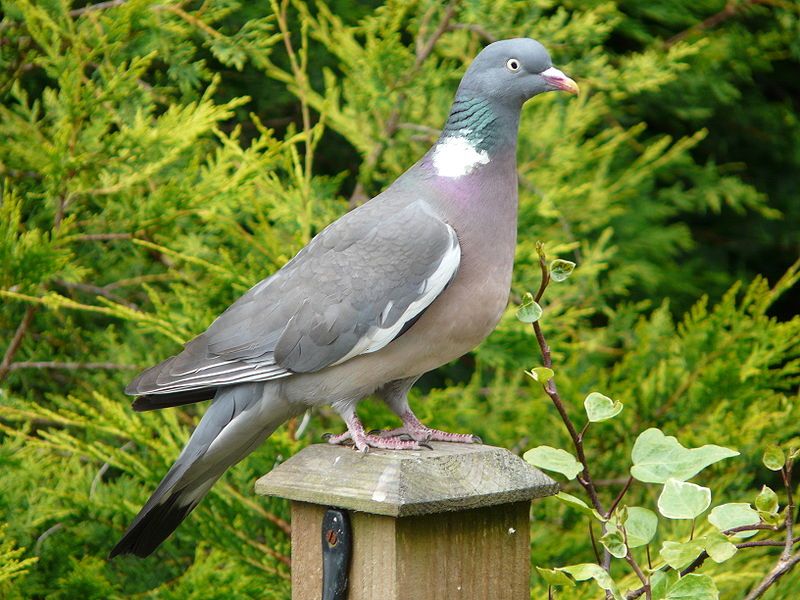
The standard wood pigeon is a widely-recognized bird species native to the western Palearctic region. It belongs to the dove and pigeon family, specifically to the genus Columba, which comprises other closely related species, such as the rock dove.
The standard wood pigeon is a large species with a body length of 33–37 cm and a 65–75 cm wingspan. It has a distinctly bluish-grey head and neck, white or greyish patches on the wings, and a black tail. The iris of the eye is yellowish-red, and the feet are red.
The standard wood pigeon is typically found in woodlands, meadows, and gardens and feeds on seeds, fruits, and crops. It is a social bird and can often be seen in flocks of up to several hundred birds.
It nests on tree branches during the breeding season, building a simple nest of twigs and grass. The standard wood pigeon is a widespread pest in some countries because it tends to feed on crops.
However, it is also a famous game bird, and its meat is considered a delicacy in some parts of the world.
| Kingdom | Animalia |
| Phylum | Chordata |
| Class | Aves |
| Order | Columbiformes |
| Family | Columbidae |
| Genus | Columba |
| Species | C. palumbus |
9. Common Kestrel
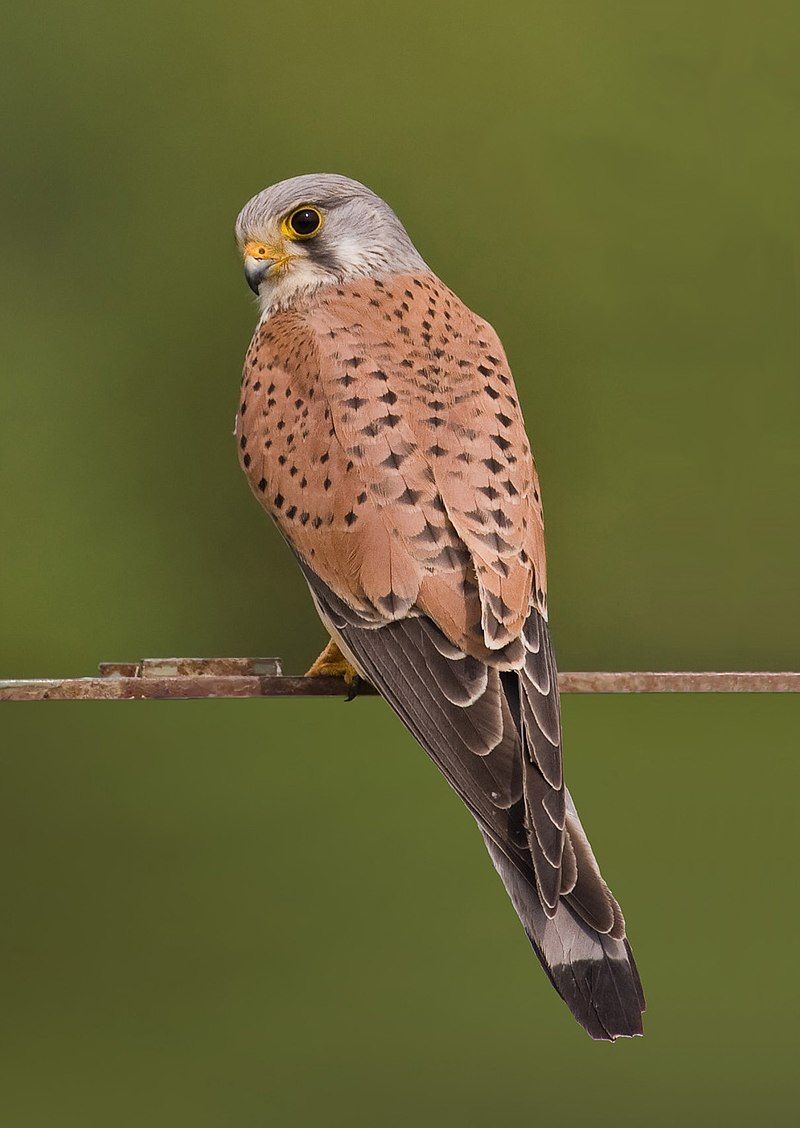
The common kestrel is a bird of prey that belongs to the falcon family. Depending on the region, it is also known as the European kestrel, Eurasian kestrel, or Old World kestrel.
It is the only kestrel species in the United Kingdom called “Kestrel.” This bird of prey has a unique appearance: its long tail and pointed wings. Its size varies from 30–35 cm in length, and a wingspan of up to 65 cm.
It has a rounded head with a black cap and a white face. The breast is usually a rusty red, and the back is a slate grey. An adult common kestrel has a distinctive call, a high-pitched “ki-ki-krrr” sound.
The common kestrel is mainly found in open farmland, grassland, and moorland habitats. They usually hunt from a perch, looking out for prey to swoop down on. This includes small mammals, reptiles, and insects. They also eat carrion, which is a dead animal.
They are known to be fearless and daring, often taking on larger birds such as crows and magpies. The common kestrel is a well-known bird species and an integral part of the ecosystem.
It is a significant predator, helping to keep the population of rodents and other small animals in check. It is also essential to the food chain, providing food for other animals such as foxes and owls.
| Kingdom | Animalia |
| Phylum | Chordata |
| Class | Aves |
| Order | Falconiformes |
| Family | Falconidae |
| Genus | Falco |
| Species | F. tinnunculus |
10. Rock Dove
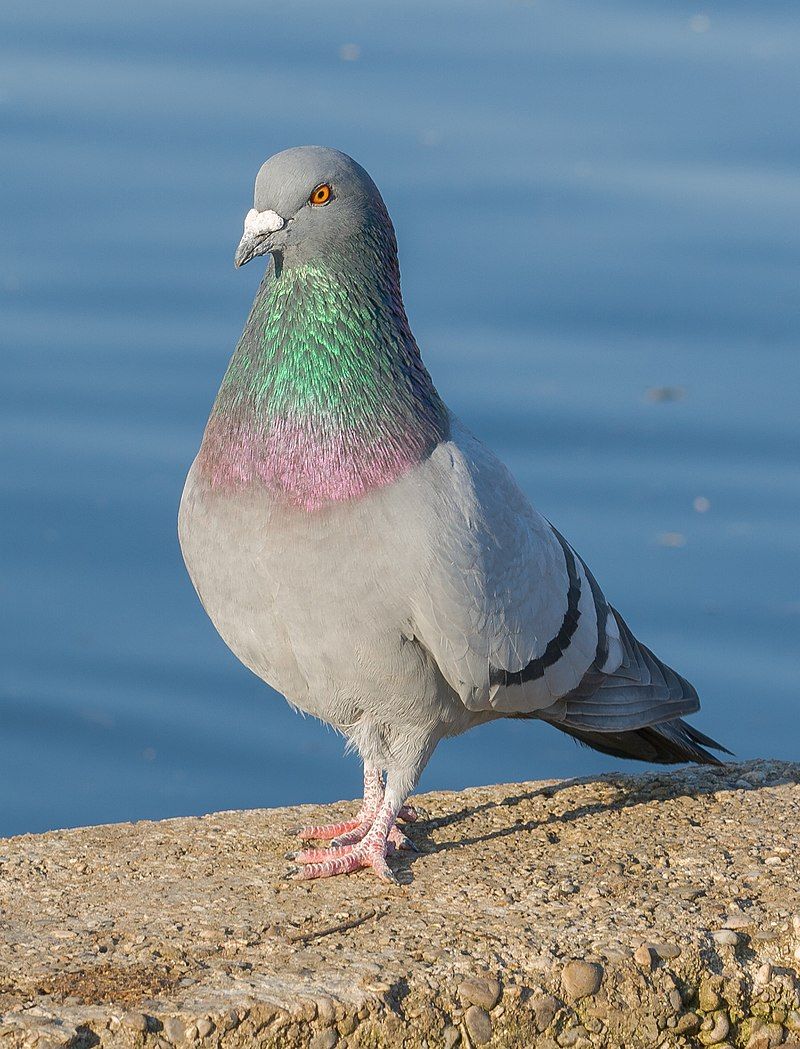
The rock dove, rock pigeon, or common pigeon is a bird species in the Columbidae family. It is commonly referred to as the “pigeon” and is the ancestor of the domestic pigeon.
With the domestication of the rock dove, many birds have escaped and formed large populations of feral pigeons worldwide. These feral pigeons are found in urban areas as well as rural areas and are considered to be a pest in some places.
The rock dove is an adaptable species with a wide range of habitats. They are found in open woodland, grassland, and cliffs, as well as in cities and towns. They are also found in agricultural areas, often nesting on buildings and eating spilled grain.
The rock dove can find food in a wide variety of places and can also feed on scraps from humans. The rock dove is a distinctive bird with a white rump, two black bars on the wings, and a blue-gray coloration.
It has a characteristic cooing call used to locate other birds. Rock doves form large flocks and are social birds, often perching on buildings or wires in large numbers. The rock dove is an important species in many cultures and has been domesticated for centuries.
It is used as a messenger in some parts of the world and plays a vital role in religious ceremonies. The rock dove has also become a symbol of peace, with a white dove often used as a sign of the end of the conflict.
| Kingdom | Animalia |
| Phylum | Chordata |
| Class | Aves |
| Order | Columbiformes |
| Family | Columbidae |
| Genus | Columba |
| Species | C. livia |
11. Common Quail
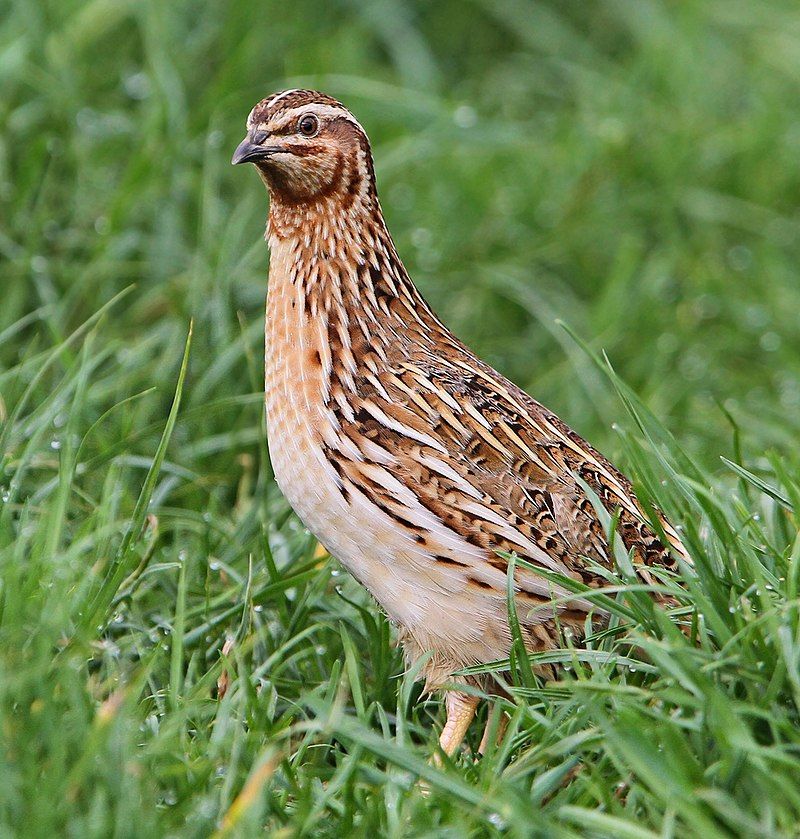
The common quail, or European quail, is a small game bird belonging to the pheasant Phasianidae family. It is found in the western Palearctic, where it breeds in the summer months and then migrates south for the winter, often traveling as far as Africa and India.
Though it is a small bird, it is easily identifiable by its distinctive call of three repeated chirps.
Despite its size, the common quail can often be heard before it is seen, making it a famous bird among birdwatchers. The common quail is a ground-nesting bird, meaning it builds its nests on the ground rather than in trees or bushes.
It prefers open habitats such as grasslands and fields, where it can easily hide from predators. It is a solitary species that will usually only be seen with its mate during breeding.
The common quail is omnivorous, feeding on plant material and small invertebrates. The common quail is a famous game bird and is hunted for its meat and eggs. It is also a renowned bird in aviculture and can be found in zoos and bird collections worldwide.
Despite its popularity, the common quail is declining in numbers due to loss of habitat and overhunting. Conservation efforts are needed to ensure the survival of this species.
| Kingdom | Animalia |
| Phylum | Chordata |
| Class | Aves |
| Order | Galliformes |
| Family | Phasianidae |
| Genus | Coturnix |
| Species | C. coturnix |
12. Turdus Merula
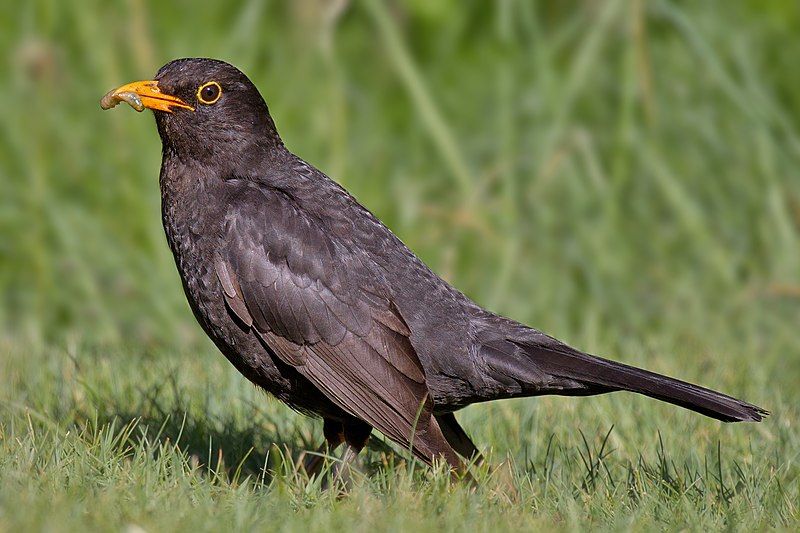
The common blackbird is a species of true thrush and is also known as the Eurasian blackbird or simply the blackbird if no other species looks similar.
This bird species is native to Europe, Asiatic Russia, and North Africa and has been introduced to Australia and New Zealand over time.
This bird species is easily identifiable due to its black feathers and yellow beak. The common blackbird typically breeds in the spring and early summer and prefers to live in woodland areas or gardens.
They usually build their nests in trees and make a distinctive chirping sound that is easily recognizable. These birds are omnivorous and feed on various items such as insects, fruits, and berries.
They also enjoy eating worms and other small invertebrates. The common blackbird is an important species for many reasons. They act as a natural pest control by eating insects, and they are also good pollinators, as they spread the pollen of many plant species.
They are also an essential food source for other species, such as owls and hawks, and they can be found in many parts of the world.
| Kingdom | Animalia |
| Phylum | Chordata |
| Class | Aves |
| Order | Passeriformes |
| Family | Turdidae |
| Genus | Turdus |
| Species | T. merula |
13. Crested lark
The crested lark is a species of lark that has a wide range across Eurasia and northern Africa. It is a bird that does not migrate but can be seen as a vagrant in Great Britain.
This means it is an uncommon sight in Britain, but the bird can occasionally be seen there. The crested lark is a small bird with a pointed bill and a distinctive crest of feathers on its head. It is a ground-dwelling bird and feeds mainly on seeds, insects, and spiders.
The crested lark lives in open grasslands and heaths and is usually found in small flocks. It is an essential species in its range, as it provides critical ecological services such as pest control and contributes to the aesthetic beauty of its habitats.
| Kingdom | Animalia |
| Phylum | Chordata |
| Class | Aves |
| Order | Passeriformes |
| Family | Alaudidae |
| Genus | Galerida |
| Species | G. cristata |
14. Eurasian Jay
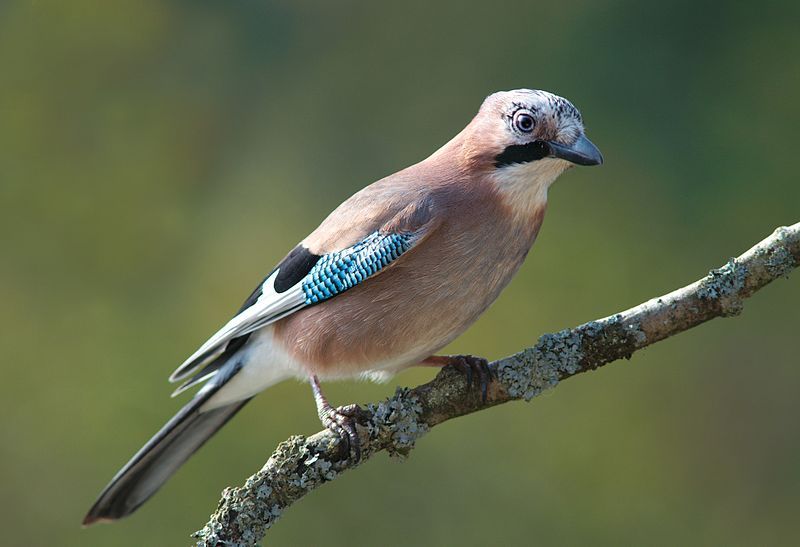
The Eurasian jay is a species of passerine bird that belongs to the Corvidae family, which includes crows. Its plumage is a pinkish brown, with a black stripe on either side of its whitish throat. Its upper wing is bright blue, and its tail is black.
The Eurasian jay is a distinctive bird, and its unique coloration makes it stand out among other birds in its family. It is also known for its intelligence, with some members of the Corvidae family being among the most intelligent birds in the world.
The Eurasian jay is a common sight in many parts of Europe and Asia, and its intelligence and striking coloration make it a much-loved bird.
| Kingdom | Animalia |
| Phylum | Chordata |
| Class | Aves |
| Order | Passeriformes |
| Family | Corvidae |
| Genus | Garrulus |
| Species | G. glandarius |
15. Great Tit
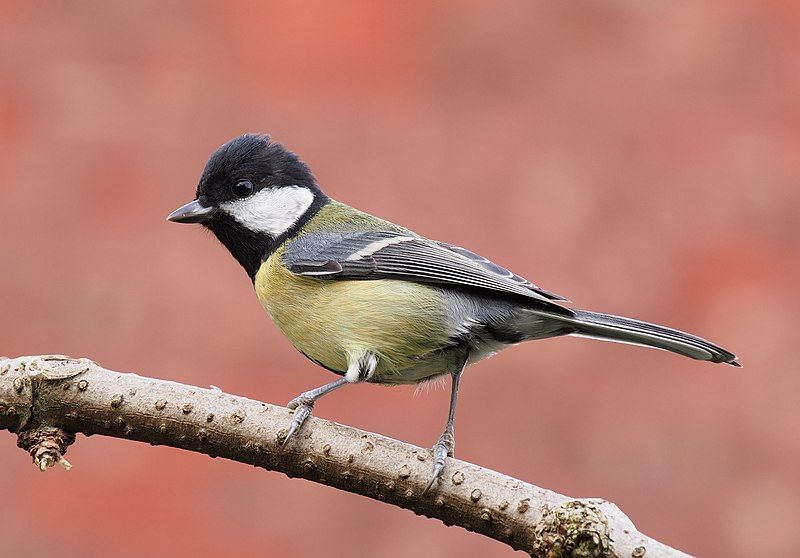
The great tit is a species of passerine bird that belongs to the tit family Paridae. It is a species found in various habitats across Europe, the Middle East, Central Asia, and, further east, across the Palearctic to the Amur River.
This range means the great tit is one of the most widespread birds in the world and often one of the most common species in its range. The great tit is an unmistakable bird with striking black and yellow plumage.
Its bright colors are a warning signal to potential predators and are believed to be used in courtship displays.
The great tit is an adaptable bird and can often be seen in both rural and urban areas, making use of a range of different habitats. The great tit is a reasonably small species, with an average length of around 16cm.
It feeds mainly on insects but can also consume other food, such as fruit and seeds. The great tit is a social species, often seen in small groups or pairs.
It is also known for its distinctive song, a mix of complex whistles and chirps. The great tit is a species of conservation concern, with its population declining in some areas due to habitat loss. However, it is still listed as the most minor concern by the IUCN.
In some areas, significant tit populations are increasing due to the availability of food and nesting sites in urban habitats.
| Kingdom | Animalia |
| Phylum | Chordata |
| Class | Aves |
| Order | Passeriformes |
| Family | Paridae |
| Genus | Parus |
| Species | P. major |
16. Little Owl
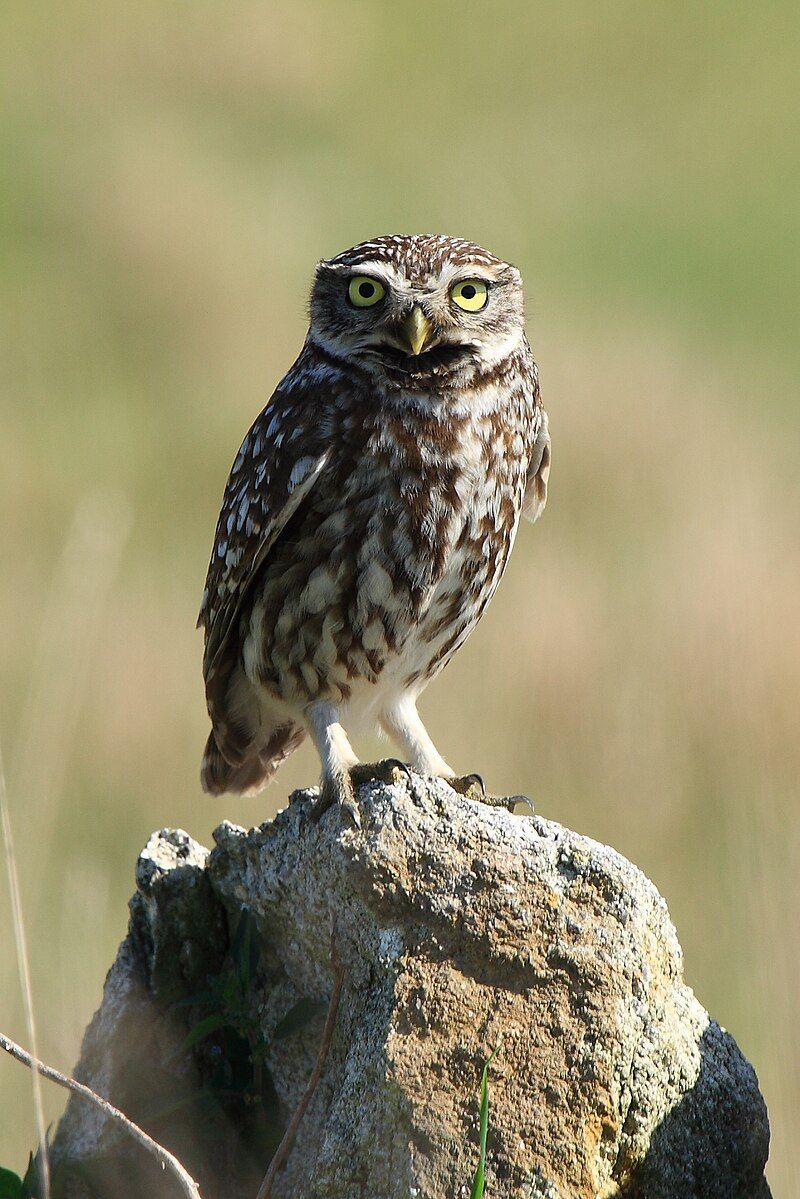
The little owl, also known as the owl of Athena or the owl of Minerva, is a bird species found in temperate and warmer climates across Europe, East Asia, and North Africa.
It was introduced to Britain in the late 1800s and the South Island of New Zealand in the early 1900s.
This owl species prefers open country with scattered trees, such as farmland, pastures, and parks, and is well known for its nocturnal activity. The little owl is a small to medium-sized owl, typically growing between 15 and 20 cm long, with a wingspan of around 45 cm.
It has a round head, white face, dark eyes, and bright orange or russet plumage.
Its diet consists mainly of small mammals, insects, and some fruits and seeds. The little owl is a widespread species of owl often found in art and literature, representing wisdom, knowledge, and truth.
In Ancient Greece, the little owl symbolized the goddess Athena; in Ancient Rome, it was linked to the goddess Minerva. The little owl is also associated with wisdom and knowledge in many other cultures and is still used today to represent these qualities.
| Kingdom | Animalia |
| Phylum | Chordata |
| Class | Aves |
| Order | Strigiformes |
| Family | Strigidae |
| Genus | Athene |
| Species | A. noctua |
17. European Roller
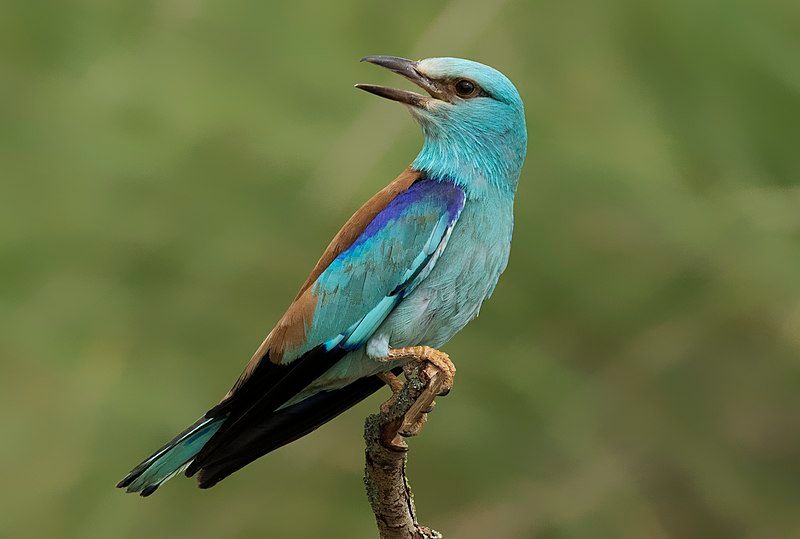
The European Roller (Coracias garrulus) is a unique species of bird found in Europe, as it is the only member of its family that breeds in this region. Its range extends into the Middle East, Central Asia, and the Maghreb.
This bird is quite adaptable, as it is found in various habitats, though it typically avoids treeless plains. Regarding nesting, the European Roller prefers to make its home in tree holes.
This bird is striking, with its steel-blue wings, bright chestnut back, and long tail. It feeds mainly on insects, catching them in mid-air, and it is known to make a loud rasping call. The European Roller is found in pairs or small groups during the breeding season.
It is a territorial bird, and it will fiercely defend its nesting grounds during this time. The European Roller is an essential part of the European ecosystem. It is a crucial predator of many insect species, including those that can damage crops.
As a result, it plays a vital role in helping to maintain a healthy agricultural system. In addition, the European Roller is an essential species for conservationists, as its populations are declining due to various factors, including habitat loss and illegal trapping.
| Kingdom | Animalia |
| Phylum | Chordata |
| Class | Aves |
| Order | Coraciiformes |
| Family | Coraciidae |
| Genus | Coracias |
| Species | C. garrulus |
18. Eurasian Magpie
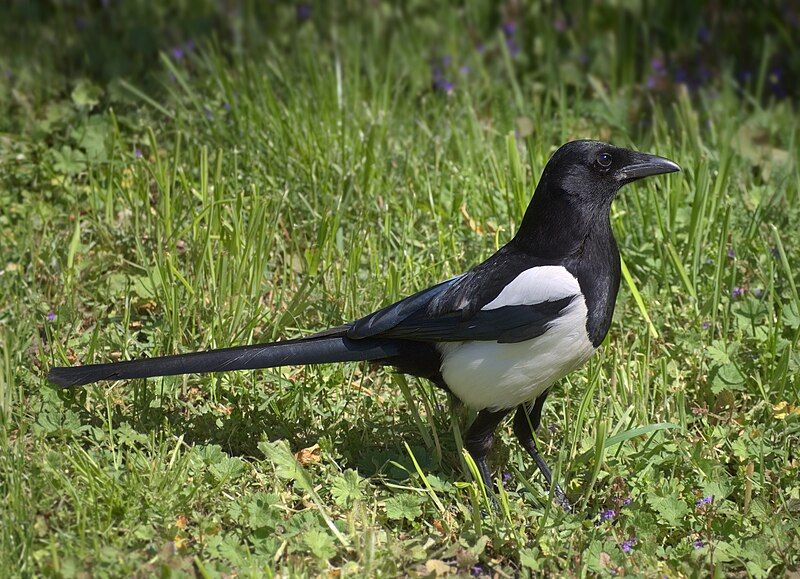
The Eurasian magpie, also known as the common magpie, is a type of bird found throughout the northern part of the Eurasian continent. It is part of the crow family and part of a group of birds referred to as “monochrome” magpies.
This bird is a resident breeding bird, meaning it builds nests and breeds in the same area yearly. It is a relatively large bird with a distinctive black-and-white coloration. This bird is brilliant and is known for its mischievous behavior.
It is also very vocal, with various calls and noises used to communicate with other magpies. The Eurasian magpie is a fascinating bird species that scientists have studied for many years.
| Kingdom | Animalia |
| Phylum | Chordata |
| Class | Aves |
| Order | Passeriformes |
| Family | Corvidae |
| Genus | Pica |
| Species | P. pica |
19. Western Rock Nuthatch
The western rock nuthatch is a small bird found in various countries, from Croatia to Iran. This species is primarily sedentary, meaning they remain in the exact location year-round, although some migrate after breeding.
The eastern rock nuthatch, a distinct species, can be found further east in south-central Asia.
This species also migrates after breeding, and their migratory patterns are believed to help them avoid environmental hazards such as droughts and other extreme weather conditions.
The two species of rock nuthatches are similar in size and appearance but have different habits and behaviors that help them survive in their respective habitats.
| Kingdom | Animalia |
| Phylum | Chordata |
| Class | Aves |
| Order | Passeriformes |
| Family | Sittidae |
| Genus | Sitta |
| Species | S. neumayer |
Conclusion
Nevşehir’s avian diversity offers a captivating array of birdwatching opportunities. With its unique landscape encompassing valleys, rock formations, and wetlands, this region attracts a remarkable variety of bird species throughout the year.
From the majestic Griffon Vultures soaring above the fairy chimneys to the delicate colors of the European Bee-eaters gracing the skies, each bird adds to the rich tapestry of nature found in Nevşehir.